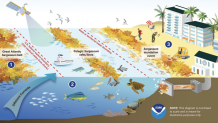It’s the season for seaweed. NBC6’s Ari Odzer reports
It's the season for seaweed, and researchers say it's back with a vengeance: the month of April broke records for the amount of sargassum in the tropical Atlantic and the Caribbean Sea.
According to the University of South Florida's Optical Oceanography Lab (OOL), which monitors the distribution of this brown macroalgae, April's bloom "was 40% higher than the all-time high in June 2022, which makes 2025 a new record year."
Watch NBC6 free wherever you are
So exactly how big is it?
"It's huge," Dr. Chuanmin Hu, professor of Oceanography at USF’s College of Marine Science, says. "Typically if it's just 5%, 10% over a record it's not big, but now we see 40% higher than historical records... and in terms of the total amount, we have about 30 million metric tons in the tropical Atlantic and the Caribbean sea."
Get local news you need to know to start your day with NBC 6's News Headlines newsletter.
Videos captured an inundation event at area beaches back in April. But how much more can we expect, and when? And is this growing vegetation cause for concern?
Here's what you need to know.

Will South Florida beaches get inundated with sargassum this summer?
Local
The Optical Oceanography Lab's April bulletin says that as in previous years, the bloom is expected to grow in May in most regions of the Caribbean Sea and Gulf of Mexico.
But, Hu cautions, "even if a portion of that large amount eventually reaches these straits of Florid and southeast coast of Florida, whether or not that sargassum would be washed on the beach is still variable, depending on local winds and tides."
For instance, there's good news for beachgoers this weekend (May 9-11): the winds aren't favorable for a sargassum inundation.
Still, the bulletin reads that "sargassum inundation will continue to occur in most of the Caribbean nations and islands as well as along the southeast coast of Florida."
When could South Florida see sargassum inundations in 2025?
There isn't an exact way to predict when seaweed will hit the beach, since there are so many factors to its transport and growth.
For now, "the majority of sargassum is really far away," Hu says. "There's some moderate amount in the western Caribbean sea, but it will take a month or more for that sargassum to reach Florida."
Why is there more seaweed in the ocean?
Researchers know that sargassum will keep growing if it gets adequate sunlight and nutrients.
But a lot of what's causing these blooms remains a mystery, and a current topic of investigation.
"Our speculation is that this year the wind is stronger than usual, and that will bring more deep water nutrients to the surface water to fuel this plant," Hu said. "The ocean itself is [also] warmer than usual, so that means this plant is happier."
But scientists also can't yet predict exactly how much a bloom will grow.
"The reason is that the ocean is really huge," Hu said. "If you want to send a boat to measure something, remember you are just measuring a point. It's really difficult to generalize."

Does climate change have a role to play in the growing blooms of seaweed?
"It has a big role," Hu said. "Let me put it in another way. We call it climate variability... one of the consequences of climate change is we have a more extreme weather, either too much precipitation or too dry, too warm or two cold."
The warm water is favorable for the growth of sargassum.
Is sargassum good or bad for the environment?
In January, Dr. Dennis McGillicuddy, the senior scientist in the Department of Applied Ocean Physics and Engineering at the Woods Hole Oceanographic Institution in Cape Cod, Massachusetts, spoke to NBC6 about his research on sargassum.
Despite playing what McGillicudy describes as an essential role in a balanced environment, “like many other things, too much of a good thing can be a bad thing, and that's what we've seen in the recent blooms of sargassum.”
Specifically, if the bloom is too large, it could block sunlight and have negative consequences for sea grasses and coral reefs.
"Another direct consequence we see of this in the coastal ocean has to do with animals that use the coastal environment for reproduction," McGillicuddy says. "As you probably know, loggerhead turtles, their preferred nesting environment are beaches. And so we've seen situations when the adults can't get ashore to lay their eggs, and then those that are lucky enough to lay their eggs, the hatchlings have difficulty getting back out into the ocean because of the seaweed barrier that's created by sargassum."
Its cleanup is also expensive.
"The local governmental agencies already spend a lot of effort and money to clean the beaches," Hu said. "I heard from our collaborators... they spent a half million or million of dollars a year to clean the beach. It's not just the cleaning. Once they remove sargassum, where do they put it?"



